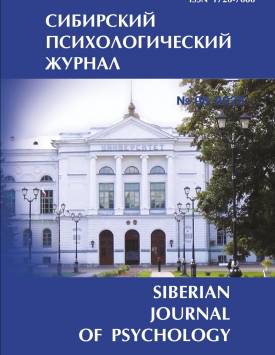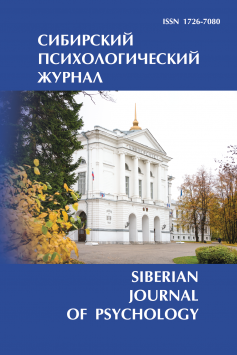Types of Thinking and Verbal Intelligence in the Context of a Psychophysiological Problem
The article presents the results of the study of the relationship between thinking styles and verbal intelligence of future specialists of helping professions in the context of a psychophysiological problem as the correlation of mental and psychophysiological, and as an attempt to study the work of brain departments based on the psychometric technique of K. Benziger. The aim of the study is to determine the correlation between types of thinking and verbal intelligence. When the goal is realized, we can assume the correlation of thinking types and verbal intelligence having psychophysiological correlates. Thinking types and cognitive style analytical - holistic are interpreted in terms of methodological provisions of K. Benziger, verbal intelligence - two-factor theory of verbal intelligence as individual mental experience of A. P. Lobanov. The first stage of the study involved 184 respondents, during which the expression of four types of students' thinking was determined depending on the conditional expression of activity in different lobes of the cerebral hemispheres, taking into account the regional factor according to the method “Assessment of Thinking Styles” by K. Benziger. At the second stage the subject of the study was the relationship between the types of thinking and verbal (concrete and abstract) intelligence in 77 students who performed the method “Assessment of thinking styles” by K. Benziger and “Leading way of grouping” by A. P. Lobanov. The results of the study showed the dominance of holistic thinking strategy over analytical strategy in students regardless of the regional factor (educational institution), which is typical for future specialists of helping professions. According to the methodology, students of BSPU (Minsk) have more pronounced activity in the anterior and posterior lobes of the left hemisphere; students of GrSU (Grodno) - in the anterior and posterior lobes of the right hemisphere. The differences between the groups of subjects were statistically significant only in the expression of activity in the right posterior lobe of the brain, providing general emotionalism, sense of belonging and efficiency of nonverbal communication. The results of factorization reflected the effect of dynamic interaction of two types of verbal intelligence, when phases of complementarity can be replaced by periods of their opposition; activity of functioning of concrete and abstract intelligence in the posterior/anterior brain areas. The obtained results require refinement and special further research with physiologists, which will make it possible to clarify the boundaries of localization of brain activity characteristic for each type of thinking studied by K. Benziger's methodology.
Keywords
thinking styles,
analytical strategy,
holistic strategy,
verbal intelligence,
mental representation,
psychophysiological problemAuthors
| Lobanov Alexander P. | Belarusian State Pedagogical University named after Maxim Tank | lobanov.ap@outlook.com |
| Drozdova Nataliya V. | Belarusian State Pedagogical University named after Maxim Tank | drozdova_33@mail.ru |
| Pevneva Anzhela N. | Yanka Kupala State University of Grodno | pevneva_AN@grsu.by |
Всего: 3
References
Айзенк, Г., Кэмин, Л. (2002). Природа интеллекта. Битва за разум. М.: Эксмо-Пресс.
Апанович, В. В., Арамян, Э. А., Дольникова, М. С., Александров, Ю. И. (2021). Различия мозгового обеспечения решения аналитических и холистических задач. Психологический журнал, 42(2), 45-60. doi: 10.31857/S020595920014240-0.
Апанович, В. В., Знаков, В. В., Александров, Ю. И. (2017). Апробация шкалы аналитичности-холистичности на российской выборке. Психологический журнал, 38(5), 80-96. doi: 10.7868/S0205959217050075.
Барабан, И. И. (2023). Гендерные различия в характеристиках когнитивных стилей курсантов, обучающихся управлению воздушным движением. Научно-практический журнал «Право. Экономика. Психология», 3(31), 76-81.
Бизюк, А. П. (2005). Компендиум методов нейропсихологического исследования, метод. пособие. СПб.: Речь.
Бушов, Ю. В. (2022). Психофизиологические механизмы и индивидуальные особенности восприятия времени. Вестник психофизиологии, 7(1), 46-59. doi: 10.34985/k1730-9730-9775-n.
Веккер, Л. М. (2000). Психика и реальность: единая теория психических процессов. М.: Смысл; Per Se.
Волкова, Е. В., Докучаев, Д. А. (2022). Импульсивность-рефлексивность и нейроэффективность интеллектуальной деятельности. Экспериментальная психология, 15(2), 125-143. doi: 10.17759/exppsy.2022150210.
Глущенко, В. В. Шабаев, В. С. (2017). Нейрофизиологические показатели активности внимания. Вестник Новгородского государственного университета им. Ярослава Мудрого, 5(106), 110-112.
Гужов, В. И., Винокуров, А. А., Марченко, И. О., Савин, М. А. (2015). Пространственная локализация функций в коре головного мозга. Инженерный вестник Дона, электронный научный журнал, 4. URL: http://ivdon.ru/ru/magazine/archive/n4y2015/3343.
Дикая, Л. А. (2010). Нейрофизиологические коррелята: музыкальной творческой деятельности. Сибирский психологический журнал, 36. 46-52.
Каратыгин, Н. А., Коробейникова, И. И., Венерина, Я. А., Венерин А. А., Александров, Ю. И. (2022). Связь спектральных характеристик тета-ритма ЭЭГ с результативностью выполнения когнитивного теста «n-back». Экспериментальная психология, 15(2), 95-110. doi: 10.17759/exppsy.2022150208.
Кольцова, В. А., Ждан, А. Н. (2015). Учение И. М. Сеченова о рефлексах головного мозга: манифест русской объективной психологии. Психологический журнал, 36(2), 70-77.
Лобанов, А. П. (2010). Интеллект и ментальные репрезентации: образовательный подход. Минск : БГПУ.
Лобанов, А. П. Дроздова, Н. В. Морозов, А. А. (2021). Вербальный интеллект и его психофизиологические корреляты. В сб.: В. В. Рубцов, М. Г. Сорокова, Н. П. Радчикова (ред.) Цифровая гуманитаристика и технологии в образовании (DHTE 2021): сб. ст. И-й Всерос. науч.-практ. конф. с междунар. участием (с. 326-346). М.: Изд-во ФГБОУ ВО МГППУ.
Лобанов, А. П., Орлова, Д. А., Дроздова, Н. В., Добриян, Ю. М. (2020). Окуломоторная активность студентов с конкретным и абстрактным вербальным интеллектом: айтрекинг в когнитивных исследованиях. Вышэйшая школа: навукова-метадычны и публкцыстычны часопис, 2, 42-46.
Логинова, Н. А., Осорина, М. В., Холодная, М. А., Чередникова, Т. В. (2018). Единая теория психических процессов Л. М. Веккера в современной психологии (к 100-летию со дня рождения). Психологический журнал, 39(6), 102-113. doi: 10.31857/S020595920002257-8.
Певнева, А. Н. (2023). Нейрофизиологические особенности функционирования когнитивной ригидности в Струп-парадигме. Вестник Белорусского государственного педагогического университета. Сер. 1. Педагогика. Психология. Филология, 4, 80-84.
Пермякова, М. Е., Коваленко, В. Я., Виндекер, О. С. (2019). Исследование взаимосвязи когнитивных стилей и их особенностей у юношей и девушек. Перспективы науки и образования, 6(42), 251-261. doi: 10.32744/pse.2019.6.21.
Пиаже, Ж. (1969). Избранные психологические труды: Психология интеллекта. Генезис числа у ребенка. Логика и психология. М.: Просвещение.
Плотникова, А. В., Кудрин, Р. А., Ахундова, Р. Е. (2015). Типологические особенности интеллекта и биоэлектрической активности головного мозга у лиц с разным хронотипом. Вестник Волгоградского государственного медицинского университета, 1(53), 58-61.
Ратанова, Т. А. (2011). Время реакции в системе изучения природы интеллекта и специальных способностей. Экспериментальная психология, 4(3), 86-96.
Ричардсон, Т. Э. Дж. (2006). Мысленные образы: когнитивный подход. М. : Когито-Центр. Сеченов, И. М. (2001). Элементы мысли. СПб.: Питер.
А.П. Лобанов, Н.В. Дроздова, А.Н. Певнева Солсо, Р. Л. (2011). Когнитивная психология. СПб.: Питер.
Чуприкова, Н. И. (2007). Умственное развитие: принцип дифференциации. СПб.: Питер.
Kosslyn, S. M. (1987). Seeing and imagining in the cerebral hemispheres: A computational approach. Physiological Review, 94, 148-175.
Kosslyn, S. M. (1994). Image and bran: The resolution of the imagery debate. MIT press.
Kounios, J., & Beeman, M. (2014). The cognitive neuroscience of insight. Annual review of psychology, 65(1), 71-93. doi: 10.1146/annurev-psych-010213-115154.
Leonard, N. R., Gwadz, M. V., Ritchie, A., Linick, J. L., Cleland, C. M., Elliott, L., & Grethel, M. (2015). A multi-method exploratory study of stress, coping, and substance use among high school youth in private schools. Frontiers in psychology, 6, 1028. doi: 10.3389/fpsyg.2015.01028.
Limanowski, J. (2022). Precision control for a flexible body representation. Neuroscience & BiobehavioralReviews, 134, 104401. doi: 10.1016/j.neubiorev.2021.10.023.
Pratchett, T., Young, G., Brooks, C, Jeskins, L, & Monagle, H. (2016). Benziger Thinking Styles Assessment (BTSA). In G. Young (Ed.), Practical Tips for Developing your Staff. Facet Publishing.
Sechenov, I. M. (2001). Elementy mysli [Elements of Thought]. St.Petersburg: Piter.
Solso, R. L. (2011). Kognitivnayapsikhologiya [Cognitive Psychology]. St.Petersburg: Piter.

